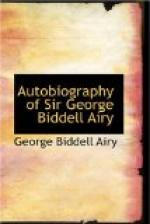Of private history: “I was at Playford until Jan. 19th, in close correspondence as usual with Mr Christie at the Observatory, and attending to my Numerical Lunar Theory.—From Mar. 29th to Apr. 2nd I went on a short trip to Hereford, Worcester, &c.—From June 8th to 20th I was at Playford.—From Aug. 13th to Sept. 8th Airy was on an expedition in Ireland, chiefly in the North and West, with his daughters. When at Dublin he visited Grubb’s instrument factory. On the return journey he stayed for some time in the Lake District of Cumberland, and took soundings in the neighbourhood of the place of the ‘floating island’ in Derwentwater.”
Airy took the greatest interest in antiquarian matters, whether military or ecclesiastical, and his feelings on such matters is well illustrated by the following letter:
ROYAL
OBSERVATORY, GREENWICH, S.E.
1877,
February 27.
DEAR SIR,
I venture to ask if you can assist me in the following matter.
In the Parish Church of Playford, near Ipswich, Suffolk, was a splendid brass tombstone to Sir Thomas Felbrigg. By an act of folly and barbarism, almost unequalled in the history of the world, the Incumbent and Curate nearly destroyed the brass inscription surrounding the image of the Knight.
This tombstone is figured in Gough’s Sepulchral Antiquities, which, I presume, is to be found in the British Museum.
And I take the liberty to ask if you would kindly look at the engraving, and give me any suggestion as to the way in which some copies of it could be made, in a fairly durable form. I am connected with the parish of Playford, and am anxious to preserve for it this memorial of a family of high rank formerly resident there.
I am, dear Sir,
Very faithfully yours,
G.B. AIRY.
T. Winter Jones, Esq.
To this request Mr Winter Jones immediately acceded, and the engraving was duly photographed, and copies were circulated with a historical notice of Sir George (not Sir Thomas) Felbrigg and a history of the Monument. Sir George Felbrigg was Esquire-at-Arms to Edward III., and Lord of the Manor of Playford: he died in 1400, and was buried in the North wall of Playford Church.




